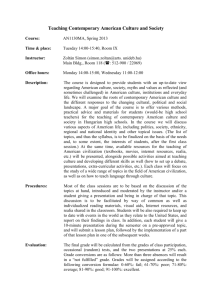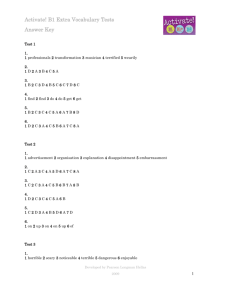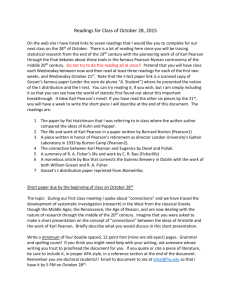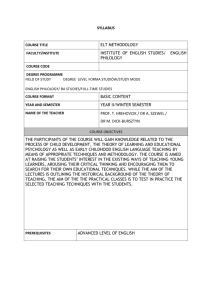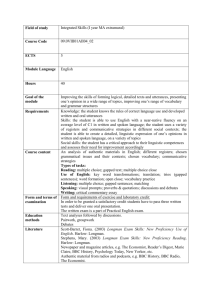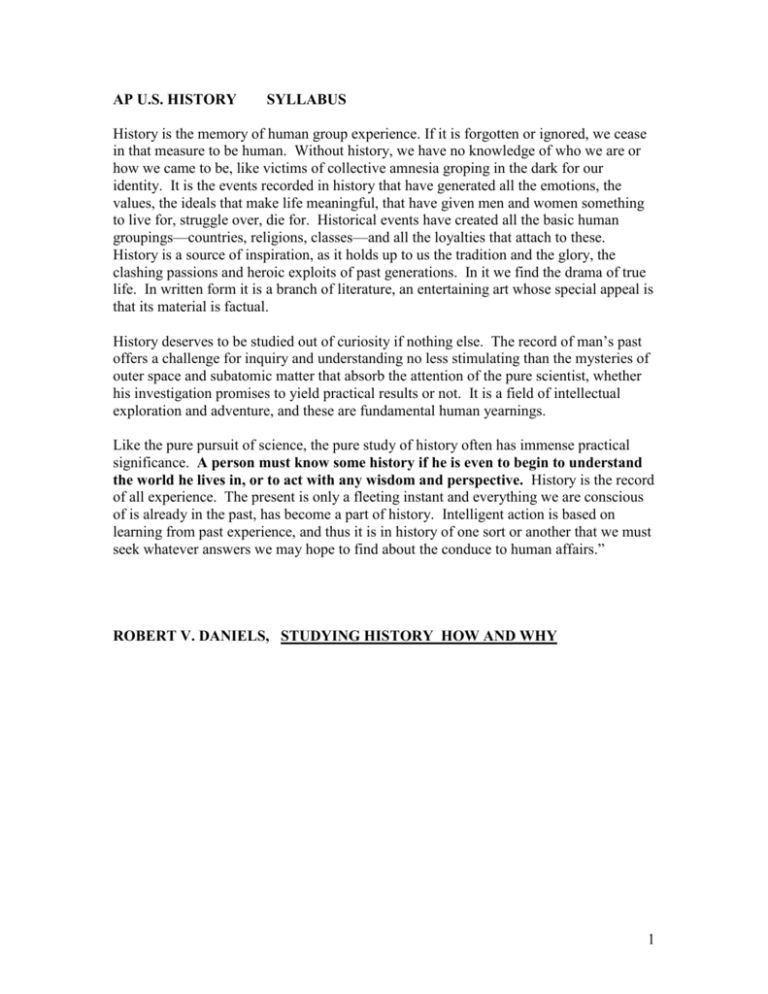
AP U.S. HISTORY
SYLLABUS
History is the memory of human group experience. If it is forgotten or ignored, we cease
in that measure to be human. Without history, we have no knowledge of who we are or
how we came to be, like victims of collective amnesia groping in the dark for our
identity. It is the events recorded in history that have generated all the emotions, the
values, the ideals that make life meaningful, that have given men and women something
to live for, struggle over, die for. Historical events have created all the basic human
groupings—countries, religions, classes—and all the loyalties that attach to these.
History is a source of inspiration, as it holds up to us the tradition and the glory, the
clashing passions and heroic exploits of past generations. In it we find the drama of true
life. In written form it is a branch of literature, an entertaining art whose special appeal is
that its material is factual.
History deserves to be studied out of curiosity if nothing else. The record of man’s past
offers a challenge for inquiry and understanding no less stimulating than the mysteries of
outer space and subatomic matter that absorb the attention of the pure scientist, whether
his investigation promises to yield practical results or not. It is a field of intellectual
exploration and adventure, and these are fundamental human yearnings.
Like the pure pursuit of science, the pure study of history often has immense practical
significance. A person must know some history if he is even to begin to understand
the world he lives in, or to act with any wisdom and perspective. History is the record
of all experience. The present is only a fleeting instant and everything we are conscious
of is already in the past, has become a part of history. Intelligent action is based on
learning from past experience, and thus it is in history of one sort or another that we must
seek whatever answers we may hope to find about the conduce to human affairs.”
ROBERT V. DANIELS, STUDYING HISTORY HOW AND WHY
1
Grading and Expectations
My primary goal, as your teacher, is to provide you the student, with a through and wellrounded course in U.S. History. My secondary goal is to prepare you for the Advanced
Placement examination given in May. Through an in-depth study and analysis of the
events, people and documents which have affected the development of this nation, both
goals can be readily achieved with your dedication and hard work!
The success of this course depends in no small manner upon your involvement in this
class. Consequently, as a student in AP US History you will have the following
responsibilities:
Taking notes from class lectures
Participation in class discussions
Consistent class attendance
Submitting all assignments in a timely manner
One book report per semester
Two movie critiques per semester
Evaluate and interpret historical documents
Full participation in class simulations
Completion of a short historical research paper
Prepare for the AP Exam
This course will be taught chronologically; nevertheless, there are several topics which
naturally lend themselves to being studied thematically (e.g. a thorough study of the
Constitution and Bill of Rights needs to include the various Supreme Court decisions
attempting to interpret these documents.) Special attention will be paid to political
institutions, social and cultural developments, diplomacy, and economic trends in U.S.
history. In conjunction with the chronological topics, the following themes will be
developed: American Diversity, American Identity, Culture, Demographic Changes,
Economic Transformations, Environment, Globalization, Politics and Citizenship, and
Reform, Religion, Slavery and Its Legacies, and War.
Each unit contains assigned chapters from the textbook. You will be held responsible
for reading these assigned chapters prior to their discussion in class. Pop tests/in-
2
class essays may be given over the assigned readings. BEING UNPREPARED FOR
CLASS WILL NEGATIVELY AFFECT YOUR GRADE!!!!!
Due to the nature of the course and the constraints of time, a great amount of information
must be disseminated quickly. Consequently, you must attend class regularly. When an
absence does occur, it is your responsibility to ascertain what you missed and to
catch up with the class. Since this is a college level class, you must take
responsibility for your actions.
All papers will be given two grades—one for content and one for mechanics.
Consequently, it will behoove you to proofread all assignments before submission.
AP U.S. History will help you develop your verbal, written, and analytical skills and will
enhance your understanding of contemporary issues. Grades will be based on the
following assessments:
40% Tests and quizzes
40% Class work and Home work
20% Projects
Tests and quizzes will be multiple-choice as will the Midterm in December. The Final
exam consists of two parts: a multiple-choice exam and the short research paper on an
approved U.S. history topic. DBQs will be in-class, closed-note timed assessments.
A book report is required each semester. Also two move critiques are due each semester.
Due dates will be provided in class.
3
BOOK REPORT
The book report(s) must deal with some aspect of U.S. HISTORY. The actual choice
of books will be left up to you, although there is a suggested book list in the syllabus.
The book must be approved by me in advance. No book reports will be accepted
unless the book has been approved. Everyone must read a different book. Although
the actual length of the reports will be left to the student’s discretion, the typical report
usually averages between two-three (2-3) pages typed, double-spaced. Make every
effort to ensure that they are neat and legible. Reports will receive two grades: one for
content and one for mechanics. Extra Credit may be earned by orally presenting book
report to the class thereby sharing the information from the book with the entire class.
The book reports will include the following:
A.
A brief summary of the book (assume that I have never read the book).
B.
A critical evaluation which will be accomplished by answering the following
questions:
(1) What is the author’s thesis? (In other words, what was the author’s purpose
in writing the book?)
(2) Was the author successful or unsuccessful in supporting his/her thesis?
Give at least two (2) examples from the book to support your
contention.
(3) In what way(s), if any, does the book relate to topics, concepts, etc., covered
in this class? Please give two (2) examples.
(4) In your best judgment, was the author biased or objective in the
presentation? Give two examples to support your contention.
(5) What do you feel that you learned or gained from having read this book?
(i.e. what knowledge or insights did the book provide concerning U.S.
History?)
(6) What are your general comments and feelings toward the book after having
read it? (Be sure to include any suggestions on how the author might have
improved the book or better supported the thesis.)
Of course, it goes without saying that you must read the entire book. No book report may
be made upon several chapters. Please footnote any direct quotations. Finally, I am
interested only in YOUR evaluation of the book.
4
READING LIST
FALL SEMESTER
Banner, Lois W.
Elizabeth Cady Stanton A Radical for
Women’s Rights
Beal, Merrill D.
I Will Fight No More Forever Chief Joseph
and the Nez Perce War
Beard, Charles
An Economic Interpretation of the
Constitution of the United States
Bellamy, Edward
Looking Backward
Bowen, Catherine
Miracle at Philadelphia
Boyer, Paul
Salem Possessed: The Social Origins of
Witchcraft
Brown, Dee
Bury My Heart at Wounded Knee
Callow, Alex B.
The Tweed Ring
Catton, Bruce
Reflections on the Civil War
Chadwick, Bruce
Triumvirate The Story of the Unlikely
Alliance that Saved the Constitution and
United the Nation
Chestnut, Mary Boykin
A Diary From Dixie
Connelly, Thomas Wright
The Marble Man Robert E. Lee and his
Image in American Society
Donald, David
Why the North won the Civil War
Ehle, John
Trail of Tears The Rise and Fall of the
Cherokee Nation
Faber, Doris
We The People The Story of the U.S.
Constitution Since 1787
Glathear, Joseph T.
Forged in Battle Black Regiments in the
Civil War
Goodwin, Doris Kerns
Team of Rivals The Political Genius of
Abraham Lincoln
5
Hawke,. David
Every Day Life in Early America
Katz. William Loren
Breaking the Chains African-American
Slave Resistance
Katz, William Loren
The Black West
Ketcham, Ralph, ed.
The Anti-Federalist Papers
Martin, Calvin
Keepers of the Game Indian Animal
Relationships and the Fur Trade
Martin, James Kirby
Benedict Arnold Revolutionary Hero
Martin, James Kirby
A Respectable Army The Military Origins
of the Revolution 1763-1789
Martin, James Kirby
Ordinary Courage: The Revolutionary War
Journal of Joseph Martin Plumb
Martin, James Kirby
Men in Rebellion: Higher Government
Leaders and the Coming of the American
Revolution
McCullough, David
John Adams
McCullough, David
1776
McDonald, Forrest
The Presidency of George Washington
McPherson, James Lloyd
Abraham Lincoln and the Second American
Revolution
Morgan, Edmund
American Slavery American Freedom The
Ordeal of Colonial Virginia
Morrison, Samuel Eliot
Admiral of the Ocean Sea A Life of
Christopher Columbus
Morrison, Samuel Eliot
John Paul Jones
Padover, Saul
Jefferson: A Great American’s Life and
Ideas
Paine, Thomas Wright
Common Sense
6
Rossiter, Clinton Carbon
1787: The Grand Convention
Schlereth, Thomas J.
Victorian America Transformation in
Everyday Life 1876-1915
Shaara, Jeff
Gods and Generals
Shaara, Jeff
The Last Full Measure
Shaara, Michael
The Killer Angels
Swankey, W.A.
First Blood The Story of Fort Sumter
Vandiver, Frank Castro
Their Tattered Flags
Ward, John William
Andrew Jackson: Symbol for an Age
Williams, T. Harry
Lincoln and His Generals
Woodward, C. Vann
The Strange Career of Jim Crow
READING LIST SPRING SEMESTER
Allen, Frederick Lewis
Only Yesterday An Informal History of the
1920s
Beschloss, Michael R.
May-Day Eisenhower, Khrushchev and the
U-2 Affair
Burns, James McGregor
Roosevelt: The Lion and the Fox
Divine, Robert A.
The Reluctant Belligerent: American Entry
into World War II
Gaddis, John Lewis
The United States and the Origins of the
Cold War
Galbraith, John Kenneth
The Great Crash
Goodwin, Doris Kerns
The Fitzgeralds and the Kennedys
Goodwin, Doris Kerns
LBJ and the American Dream
7
Goodwin, Doris Kerns
No Ordinary Time Franklin and Eleanor
Roosevelt The Home Front in WWII
Graeber, William S.
The Age of Doubt American Thought and
Culture in the 1960s
Griffith, Robert
The Politics of Fear Joseph McCarthy and
the U.S. Senate
Hartman, Susan M.
The Home Front and Beyond American
Women in the 1940’s
Jaworski, Leon
The Right and the Power
Jones, James H.
Bad Blood The Tuskegee Syphilis
Experiment A Tragedy of Race and
Medicine
Kaufman, Burton J.
The Presidency of James Earl Carter
Kennedy, David
Freedom From Fear
Kennedy, Robert
Thirteen Days
Larson, Rebecca
Richard Nixon Rise and Fall of a President
Leuchtenburg, William
The Perils of Prosperity 1914-1932
McCullough, David
Truman
McCullough, David
The Path Between the Seas The Creation of
the Panama Canal
Oshinsky, David
A Conspiracy So Immense
O’Toole, G.J.A.
The Spanish War An American Epic 1898
Prange, Gordon
At Dawn We Slept
Scharf, Lois
Eleanor Roosevelt First Lady of American
Liberalism
Smith, Daniel M.
The Great Departure: The United States and
World War 1914-1920
8
Smith, G.
When the Cheering Stopped The Last Years
of Woodrow Wilson
Spanier, John W.
The Truman-McArthur Controversy and the
Korean War
Wade, Wyn Craig
The Fiery Cross The Ku Klux Klan in
America
White, Theodore H.
Breach of Faith
Wolfe, Tom
The Right Stuff
9
MOVIE CRITIQUES
Two movie critiques are required each semester. During the Fall semester, one movie
must be from the Colonial, Revolutionary War , New Republic or Expansion/Slavery
period while the second movie must be from the Expansion/Slavery, Civil/War
Reconstruction, or Great West period. During the Spring semester, one movie must be
from the Innocent Years or Inter-War period and the second movie from the World War
II or Present Day periods. Due dates will be given in class.
PARAGRAPH ONE—INTRODUCTION
Write a short paragraph including the name of the movie, the director, producer, the three
top stars and their roles and the year the film was released. Also include when and where
you watched the film and any special comments on its release (e.g. was it an abridged or
colorized version; was it in more than one part; was it part of a series; was it based upon a
novel; was it based upon an historical event; etc.)
PARAGRAPH TWO—THE PLOT
In no more than one good paragraph, relate the plot. Of course, you will not be able to
give all the details. Just condense the main story line into 5-10 sentences.
PARAGRAPH THREE—THE REALITY
Were there any characters in the movie based on real people? If so, who were they and
were they treated with historical accuracy? Were there any real events (battles,
migrations, laws, etc.). If so, were they correct as to event, time period, etc.? If there
were no real characters or events in an historical movie, it was probably a conscious
decision on the part of the writers and director. Try to analyze why reality was omitted.
(HINT: It is very probable that you will need to do a little research for this paragraph
both to find out if people or things were real and if they were presented accurately.)
PARAGRAPH FOUR—THE SETTING
When and where was the movie set? Were the locations used depicted realistically?
How long a time span did the movie cover? Were the houses, furnishings, foods, tools,
weapons, clothes, hairstyles, shoes, streets, etc., shown with accuracy? Give some
examples of period props you think were especially well or especially poorly presented.
PARAGRAPH FIVE—EVALUATION
Give an evaluation of the film. Don’t just say, “I liked it because it was a good movie” or
“I hated it because it was boring”. Like a real film critic, point out the strengths and
weaknesses of the movie. Which actors did a good job and which were inadequate?
Were there places where the plot was vague, too slow or too fast? Were there
stereotyped roles or rounded characterizations? Did the story build to a logical climax
10
and resolve itself satisfactorily? Did it hold the viewer’s interest uniformly? Why? If
the film was done many years ago, would it be done differently now? Why? Did the fim
make the viewer more aware of history or just confuse the issue? What would have made
the film better? Would you recommend this film to another student? Why or why not?
MOVIE LIST
COLONIAL PERIOD (1492-1760)
Alleghany Uprising
Black Robe
Columbus: The Discovery
Daniel Boone
1492 Conquest of Paradise
The Last of the Mohicans
Northwest Passage
Drums Along the Mohawk
The Broken Chain
The Crucible
John Wayne
Lothaire Bluteau
Tom Selleck
George O’Brian
Gerald Depardeu
Daniel Day Lewis
Spencer Tracy
Henry Fonda
Pierce Brosnan
Daniel Day Lewis
1939
1991
1992
1936
1992
1992
1939
1939
1993
1996
REVOLUTIONARY PERIOD (1760-1800)
John Paul Jones
Bastard
The Crossing
April Morning
The Rebels
1776
John Adams
George Washington
Sally Hemmings
Jefferson in Paris
The Patriot
Robert Stack
Andrew Stevens
Jeff Daniels
Tommy Lee Jones
Andrew Stevens
Marc Daniels
Paul Giamatti
Barry Bostwick
Sam Neil
Nick Nolte
Mel Gibson
1959
1979
2000
1988
1979
1972
2008
1984
2000
1995
2000
THE NEW REPUBLIC (1800-1820)
The Buccaneer
The Far Horizons
Mutiny
Charlton Heston
Charlton Heston
Mark Stevens
1958
1958
1952
11
The President’s Lady
Young Mr. Lincoln
Thomas Jefferson
Charlton Heston
Henry Fonda
Ken Burns
1953
1939
1996
EXPANSION AND SLAVERY (1820-1860)
The Alamo
The Big Sky
Bridger
Jeremiah Johnson
The Mountain Men
Uncle Tom’s Cabin
The Autobiography of Miss Jane Pittman
Amistad
How the West Was Won
Hawaii
John Wayne
Kirk Douglas
Sally Field
Robert Redford
Charlton Heston
Avery Brooks
Cicely Tyson
Anthony Hopkins
James Stewart
Julie Andrews
1960
1962
1976
1972
1980
1987
1974
1997
1962
1966
CIVIL WAR AND RECONSTRUCTION (1860-1877)
The Day Lincoln was Shot
The Hunt for John Wilkes Booth
Race With the Devil
Gods and Generals
Gore Vidal’s Lincoln
Glory
Gettysburg
Gone With the Wind
The Civil War
Ironclads
Shenandoah
Assault at West Point
Louisiana
Gangs of New York
Rob Morrow
Toby McGuire
Stephen Lang
Sam Waterston
Morgan Freeman
Jeff Daniels
Clark Gable
Ken Burns
Virginia Madson
Jimmy Stewart
Samuel L. Jackson
Margot Kidder
Daniel Day Lewis
1998
2007
1999
2003
1988
1989
1993
1939
1992
1991
1965
1994
1975
2002
THE GREAT WEST (1877-1900)
Dances With Wolves
The Emigrants
Little Big Man
Lonesome Dove
Kevin Cosner
Max von Sydow
Dustin Hoffman
Robert Duvall
1990
1971
1976
1989
12
The Molly Maguires
They Died With Their Boots On
Far and Away
Geronimo: An American Legend
Rough Riders
Sean Connery
Errol Flynn
Tom Cruise
Matt Dillon
Tom Berenger
1969
1951
1992
1993
1997
THE INNOCENT YEARS (1900-1920)
Avalon
Eight Men Out
1918
Ragtime
Sergeant York
The Great White Hope
The Wind and the Lion
The Winds of Kitty Hawk
Wilson
A Night to Remember
Titanic
Aidan Quinn
John Cusack
Matthew Broderick
James Cagney
Gary Cooper
James Earl Jones
Sean Connery
Michael Moriarty
Alexander Knox
Clifton Webb
Leonardo Dicaprio
1991
1989
1985
1981
1941
1970
1976
1978
1944
1958
1997
THE INTERWAR YEARS (1920-1940)
All the King’s Men
Amelia Earhart
Bonnie and Clyde
The Babe
The Disappearance of Aimee
Eleanor: First Lady of the World
The Grapes of Wrath
Inherit the Wind
The Jessie Owens Story
The Life and Assassination of the Kingfish
Public Enemy
Matewan
The Pride of the Yankees
The Spirit of St. Louis
To Kill a Mockingbird
The Untouchables
The Great Waldo Pepper
Knute Rockne—All American
Seabiscuit
Eleanor and Franklin White House Years
Broderick Crawford
Susan Clark
Warren Beatty
John Goodman
Faye Dunnaway
Jean Stapleton
Henry Fonda
Spencer Tracy
Dorian Harewood
Ed Asner
Johnny Depp
James Earl Jones
Gary Cooper
Jimmy Stewart
Gregory Peck
Kevin Costner
Robert Redford
Ronald Reagan
Toby McGuire
Jane Alexander
1949
1976
1967
1991
1976
1982
1940
1960
1977
1977
2009
1987
1942
1957
1962
1987
1975
1940
2003
1977
13
The Glen Miller Story
James Stewart
1954
WORLD WAR II (1941-1945)
Come to the Paradise
Farewell to Manzanar
Fat Man and Little Boy
Patton
A League of Their Own
Midway
The Tuskegee Airmen
McArthur
Memphis Belle
Twelve O’Clock High
Dennis Quaid
Yuki Shimoda
Paul Newman
George C. Scott
Gena Davis
Charlton Heston
Lawrence Fishbine
Gregory Peck
Matthew Modine
Gregory Peck
1990
1976
1989
1970
1992
1976
1995
1977
1990
1949
POST WORLD WAR II (1945-PRESENT)
Truman
Path to War
Frost/Nixon
The Manchurian Candidate
Ali
Malcolm X
In the Heat of the Night
Big Jim McLain
Call to Glory
Doctor Strangelove
Guilty by Suspicion
Good Bye and Good Luck
Apollo XIII
“And the Band Played On”
I Was a Communist for the FBI
The Long Walk Home
Mississippi Burning
The Best Years of Our Lives
Thirteen Days
Ghosts of Mississippi
Hoffa
Roe v. Wade
The Right Stuff
Apocalypse Now
Separate But Equal
Seven Days in May
Gary Sinise
Donald Sutherland
Frank Langella
Frank Sinatra
Denzel Washington
Denzel Washington
Sidney Portier
John Wayne
Craig T. Nelson
Peter Sellers
Robert DeNiro
George Clooney
Tom Hanks
Matt Dillon
Frank Lovejoy
Whoppi Goldberg
Gene Hackman
Leon Ames
Kevin Costner
James Woods
Jack Nicholson
Holly Hunter
Sam Shepherd
Martin Sheen
Sidney Portier
Kirk Douglas
1995
2002
2008
1962
2001
1992
1967
1951
1984
1964
1991
2002
1995
1993
1951
1990
1988
1948
2001
1996
1992
1989
1983
1979
1991
1964
14
Tucker: The Man and the Dream
Charlie Wilson’s War
All the President’s Men
Quiz Show
The Jackie Robinson Story
Black Hawk Down
United 93
Jeff Bridges
Tom Hanks
Dustin Hoffman
Robert Redford
Jackie Robinson
Josh Hartnett
J.J. Johnson
1988
2007
1976
1994
1950
2001
2006
SYLLABUS
Required Course Text:
America Past and Present, Revised Eighth Edition, AP Edition, Divine, et al., New
York: Pearson Longman, 2007.
Unit 1: Pre-Columbian Societies
Content:
Early inhabitants of the Americas
American Indian empires
American Indian cultures
Readings: America Past and Present, Revised Eighth Edition, AP Edition, Divine, et al.,
Pearson Longman, New York, 2007. Chapter 1 New World Encounters.
Unit 2: Transatlantic Encounters and Colonial Beginnings, 1492-1690
Content:
First European contacts with Native Americans
Spain’s empire in North America
French colonization of Canada
English settlement of New England the Mid-Atlantic region, and the South
Servitude and Slavery
Religious diversity in the American colonies
Resistance to colonial authority: Bacon’s Rebellion, Glorious Revolution
Readings: America Past and Present, Revised Eighth Edition, AP Edition, Divine, et al.,
Pearson Longman, New York, 2007. Chapter 2, New World Experiments: England’s
Seventeenth-Century Colonies.
15
Unit 3: Colonial North America, 1690-1754 (Augus
Content:
Population growth and immigration
Transatlantic trade and the growth of seaports
The eighteenth-century back country
Growth of plantation economies and slave societies
The Enlightenment and the Great Awakening
Colonial governments and imperial policy in British North America
Readings: America Past and Present, Revised Eighth Edition, AP Edition, Divine, et al.,
Pearson Longman, New York, 2007. Chapter 3 , Putting Down Roots: Opportunity and
Oppression in Colonial Society, Chapter 4 Experience of Empire: 18th Century America.
Examination #1
Unit 4: The American Revolutionary Era, 1754-1789
Content:
The French and Indian War
Resistance to Britain
The War for Independence
The Articles of Confederation
The Constitution
Readings: America Past and Present, Revised Eighth Edition, AP Edition, Divine, et al.,
Pearson Longman, New York, 2007, Chapter 5 The American Revolution, Chapter 6 The
Republican Experiment.
Examination #2
Unit 5: The Early Republic, 1789-1815
Content:
Washington, Hamilton, and shaping of the national government
Emergence of political parties: Federalists and Republicans
Republican Motherhood
Beginnings of the Second Great Awakening
Significance of Jefferson’s presidency
Expansion into the trans-Appalachian West
American Indian resistance
Growth of slavery
The War of 1812
16
Readings: America Past and Present, Revised Eighth Edition, AP Edition, Divine, et al.,
Pearson Longman, New York, 2007, Chapter 7 Democracy in Distress, Chapter 8
Republican Ascendancy.
Examination #3
Unit 6: Transformation of the Economy and Society in Antebellum America
Content:
The transportation revolution
The creation of a national market economy
Early industrialization
Immigration and nativist reaction
Planters, yeoman farmers, and slaves in the cotton South
Readings: America Past and Present, Revised Eighth Edition, AP Edition, Divine, et al.,
Pearson Longman, New York, 2007. Chapter 9 Nation Building and Nationalism
Chapter 11 Slaves and Masters
Unit 7: The Transformation of Politics in Antebellum America
Content:
Emergence of the second party system
Judicial federalism
The Bank War
Tariff controversy
States’ rights debates
Jacksonian democracy
Readings: America Past and Present, Revised Eighth Edition, AP Edition, Divine, et al.,
Pearson Longman, New York, 2007, Chapter 10 The Triumph of White Men’s
Democracy.
Unit 8: Religion, Reform, and Renaissance in Antebellum America
Content:
Religious revivalism
Social reforms
Ideals of domesticity
Transcendentalism and utopian communities
Literary and artistic expressions
Readings: America Past and Present, Revised Eighth Edition, AP Edition, Divine, et al.,
Pearson Longman, New York, 2007, Chapter 12 The Pursuit of Perfection.
17
Examination #4
Unit 9: Territorial Expansion and Manifest Destiny
Content:
Forced removal of American Indians to the trans-Mississippi West
Western migration
Territorial acquisitions
The Mexican War
Readings: America Past and Present, Revised Eighth Edition, AP Edition, Divine, et al.,
Pearson Longman, New York, 2007, Chapter 13 An Age of Expansionism.
Examination #5
Unit 10: The Crisis of the Union
Content:
Pro- and antislavery arguments and conflicts
Compromise of 1850
The Kansas-Nebraska Act
The emergence of the Republican Party
Abraham Lincoln
The election of 1860 and secession
Readings: America Past and Present, Revised Eighth Edition, AP Edition, Divine, et al.,
Pearson Longman, New York, 2007, Chapter 14 The Sectional Crisis.
Unit 11: Civil War
Content:
Two societies at war
Mobilization, resources, internal dissent
Military strategies and foreign diplomacy
Emancipation
African Americans in the war
Social, political, and economic effects of war
Readings: America Past and Present, Revised Eighth Edition, AP Edition, Divine, et al.,
Pearson Longman, New York, 2007, Chapter 15 Secession and the Civil War.
Unit 12: Reconstruction
Content:
Presidential and Radical Reconstruction
18
Role of African Americans
Compromise of 1877
Impact of Reconstruction
Readings: America Past and Present, Revised Eighth Edition, AP Edition, Divine, et al.,
Pearson Longman, New York, 2007, Chapter 16 The Agony of Reconstruction.
Examination # 6
Unit 13: The Origins of the New South
Content:
Sharecropping
Expansion of manufacturing and industrialization
Jim Crow and disfranchisement
Readings: America Past and Present, Revised Eighth Edition, AP Edition, Divine, et al.,
Pearson Longman, New York, 2007, Chapter 16 The Agony of Reconstruction.
Unit 14: Development of the West in the Late Nineteenth Century
Content:
Expansion and development of western railroads
Competitors for the West: miners, ranchers, homesteaders, and American Indians
Gender, race and ethnicity in the West
Environmental impacts of western settlement
Readings: America Past and Present, Revised Eighth Edition, AP Edition, Divine, et al.,
Pearson Longman, New York, 2007, Chapter 17 The West.
Unit 15: Industrial America in the Late Nineteenth Century
Content:
Corporate consolidation of industry
Technological development
Labor and unions
National politics
Migration and immigration
Social Darwinism and Social Gospel
Readings: America Past and Present, Revised Eighth Edition, AP Edition, Divine, et al.,
Pearson Longman, New York, 2007, Chapter 18 The Industrial Society.
Unit 16: Urban Society in the Late Nineteenth Century
19
Content:
Urbanization and the lure of the city
City problems and machine politics
Intellectual and cultural movements and popular entertainment
Readings: America Past and Present, Revised Eighth Edition, AP Edition, Divine, et al.,
Pearson Longman, New York, 2007, Chapter 19 Toward an Urban Society.
MID TERM EXAM
Unit 17: Populism and Progressivism
Content:
Agrarian discontent
Populism
Origins of Progressive reform
Roosevelt, Taft, and Wilson as Progressive presidents
Women’s roles: family, workplace, reform
Black migration
Readings: America Past and Present, Revised Eighth Edition, AP Edition, Divine, et al.,
Pearson Longman, New York, 2007, Chapter 20 Political Realignments, Chapter 22 The
Progressive Era, Chapter 23 From Roosevelt to Wilson in the Age of Progressivism.
Examination #7
Unit 18: The Emergence of America as a World Power
Content:
American imperialism: political and economic expansion
War in Europe
The First World War at home and abroad
Treaty of Versailles
Society and economy in the postwar years
Readings: America Past and Present, Revised Eighth Edition, AP Edition, Divine, et al.,
Pearson Longman, New York, 2007, Chapter 21 Toward Empire
and Chapter 24 The Nation at War.
Examination #8
Unit 19: The New Era: 1920s
Content:
The business of America and the consumer economy
Republican politics: Harding, Coolidge, Hoover
20
Culture and religion
The struggle for equality: African Americans and women
Readings: America Past and Present, Revised Eighth Edition, AP Edition, Divine, et al.,
Pearson Longman, New York, 2007, Chapter 25 Transition to Modern America.
Examination #9
Unit 20: The Great Depression and the New Deal
Content:
Causes of the Great Depression
The Hoover administration’s response
Franklin D. Roosevelt and the New Deal
Labor and union recognition
New Deal critics
Surviving hard times: American society
Readings: America Past and Present, Revised Eighth Edition, AP Edition, Divine, et al.,
Pearson Longman, New York, 2007, Chapter 26 FDR and the New Deal.
Examination #10
Unit 21: The Second World War
Content:
The rise of fascism and militarism
American neutrality
The attack on Pearl Harbor
Fighting a multifront war
Diplomacy, war aims, and wartime conferences
The atomic bomb
Readings: America Past and Present, Revised Eighth Edition, AP Edition, Divine, et al.,
Pearson Longman, New York, 2007, Chapter 27 America and the World, 1921-1945.
Unit 22: The Home Front During the War
Content:
Wartime mobilization of the economy
Urban migration and demographic changes
Women, work, and family during the war
Civil liberties and civil rights during wartime
War and regional development
Expansion of government power
Readings: America Past and Present, Revised Eighth Edition, AP Edition, Divine, et al.,
Pearson Longman, New York, 2007, Chapter 27 America and the World, 1921-1945.
21
Examination #11
Unit 23: The United States and the Early Cold War
Content:
Origins of the Cold War
Truman and containment
The Cold War in Asia: China, Korea Vietnam, Japan
Diplomatic strategies and policies of the Eisenhower and Kennedy administrations
The Red Scare and McCarthyism
Impact of the Cold War on American society
Readings: America Past and Present, Revised Eighth Edition, AP Edition, Divine, et al.,
Pearson Longman, New York, 2007, Chapter 28 The Onset of the Cold War.
Examination #12
Unit 24: The 1950s
Content:
Emergence of the modern civil rights movement
The affluent society and poverty
Consensus and conformity
Social critics and cultural rebels
Technological change
Readings: America Past and Present, Revised Eighth Edition, AP Edition, Divine, et al.,
Pearson Longman, New York, 2007, Chapter 29 Affluence and Anxiety.
Examination #13
Unit 25: The Turbulent 1960s
Content:
From the New Frontier to the Great Society
Civil Rights
Cold War confrontations
The antiwar movement and the counterculture
Readings: America Past and Present, Revised Eighth Edition, AP Edition, Divine, et al.,
Pearson Longman, New York, 2007, Chapter 30 The Turbulent Sixties.
Unit 26: Politics and Economics at the End of the Twentieth Century
Content:
The election of 1968
Nixon’s challenges: Vietnam, China, Watergate
The energy crisis
The new Right and the Reagan revolution
Demographic changes: immigration, Sunbelt migration, aging population
22
Computers
Politics in a multicultural society
Readings: America Past and Present, Revised Eighth Edition, AP Edition, Divine, et al.,
Pearson Longman, New York, 2007, Chapter 31 To a New Conservatism, 1969-1988.
Examination #13
Unit 27: Society and Culture at the End of the Twentieth Century
Content:
Globalization and the American economy
Domestic and foreign terrorism
Environmental issues in a global context
Readings: America Past and Present, Revised Eighth Edition, AP Edition, Divine, et al.,
Pearson Longman, New York, 2007, Chapter 32 To The 21st Century, 1989-2006.
Review for Final Course Exam and AP Exam
Final Exam:
Review for AP Exam
AP Exam
GENERIC ESSAY SCORING GUIDE
AP
Grade
Scale Scale
8-9
90-100
Demonstrates superiority
Presents a clearly stated thesis supported and elaborated
upon throughout the essay
Presents a clear, logical, sophisticated argument responsive
to all aspects of the prompt
Analyzes more than describes
Confronts/discusses conflicting evidence and
interpretation
Supports arguments with specific, appropriate examples
Makes no significant factual errors
Well-organized and well-written
6-7
80-89
Demonstrates competence
Presents a clear and well supported thesis: may not be as
focused as top category
Demonstrates analysis, attempts to develop an argument
23
Addresses all aspects of the prompt, but perhaps unevenly
or in less depth
May include less supporting evidence
May contain minor errors of fact
Clearly organized and written; not exceptional, but logical
4-5
70-79
Suggests competence
Contains a thesis, but may be limited or partially developed
More descriptive than analytic
Recognizes all aspects of the question, but may treat them
very unevenly or superficially
May provide scant supporting evidence
May include significant errors
Acceptable writing
2-3
60-69
Suggests incompetence
Provides only a partial response to the question
Contains a simplistic or superficial thesis
Ineffective or inaccurate analysis
May include substantial factual errors
Responds minimally, confusedly or largely irrelevantly
Weak organization and writing
0-1
0-59
Demonstrates incompetence
Thesis confused, unfocused, absent or simply restates the
question
Misunderstands/fails to address the question in any
meaningful way
Provides largely irrelevant or incorrect information
Disorganized and poorly written
EDITORIAL COMMENTS
1.
PARAGRAPH
2.
CAPITALIZE ALL PROPER NOUNS
3.
NEEDS SUBJECT-VERB AGREEMENT
4.
DON’T CHANGE VERB TENSE
5.
AVOID RUN-ON SENTENCES
24
6.
AWKWARD/STILTED/NEEDS TO FLOW
7.
REDUNDANT
8.
AVOID USING INDEFINITE PRONOUNS
9.
SENTENCE FRAGMENT
10.
MISSPELLING
11.
VAGUE
12.
CLARIFY
13.
REWORD
14.
DO NOT END SENTENCE WITH A PREPOSITION
15.
DO NOT BEGIN SENTENCE WITH “AND” OR “BUT”
16.
WRITE LEGIBLY
25

